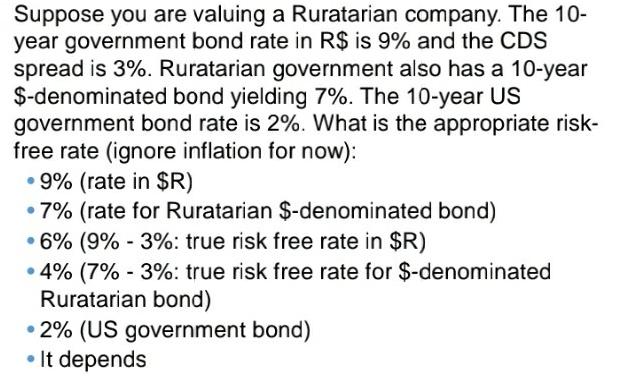Answered step by step
Verified Expert Solution
Question
1 Approved Answer
Suppose you are valuing a Ruratarian company. The 10- year government bond rate in R$ is 9% and the CDS spread is 3%. Ruratarian

Suppose you are valuing a Ruratarian company. The 10- year government bond rate in R$ is 9% and the CDS spread is 3%. Ruratarian government also has a 10-year $-denominated bond yielding 7%. The 10-year US government bond rate is 2%. What is the appropriate risk- free rate (ignore inflation for now): 9% (rate in $R) 7% (rate for Ruratarian $-denominated bond) 6% (9% - 3%: true risk free rate in $R) 4% (7% - 3%: true risk free rate for $-denominated Ruratarian bond) 2% (US government bond) It depends Suppose you are valuing a Ruratarian company. The 10- year government bond rate in R$ is 9% and the CDS spread is 3%. Ruratarian government also has a 10-year $-denominated bond yielding 7%. The 10-year US government bond rate is 2%. What is the appropriate risk- free rate (ignore inflation for now): 9% (rate in $R) 7% (rate for Ruratarian $-denominated bond) 6% (9% - 3%: true risk free rate in $R) 4% (7% - 3%: true risk free rate for $-denominated Ruratarian bond) 2% (US government bond) It depends Suppose you are valuing a Ruratarian company. The 10- year government bond rate in R$ is 9% and the CDS spread is 3%. Ruratarian government also has a 10-year $-denominated bond yielding 7%. The 10-year US government bond rate is 2%. What is the appropriate risk- free rate (ignore inflation for now): 9% (rate in $R) 7% (rate for Ruratarian $-denominated bond) 6% (9% - 3%: true risk free rate in $R) 4% (7% - 3%: true risk free rate for $-denominated Ruratarian bond) 2% (US government bond) It depends Suppose you are valuing a Ruratarian company. The 10- year government bond rate in R$ is 9% and the CDS spread is 3%. Ruratarian government also has a 10-year $-denominated bond yielding 7%. The 10-year US government bond rate is 2%. What is the appropriate risk- free rate (ignore inflation for now): 9% (rate in $R) 7% (rate for Ruratarian $-denominated bond) 6% (9% - 3%: true risk free rate in $R) 4% (7% - 3%: true risk free rate for $-denominated Ruratarian bond) 2% (US government bond) It depends
Step by Step Solution
★★★★★
3.39 Rating (152 Votes )
There are 3 Steps involved in it
Step: 1
Since it is just a ruratarian company Not a MNC Its no...
Get Instant Access to Expert-Tailored Solutions
See step-by-step solutions with expert insights and AI powered tools for academic success
Step: 2

Step: 3

Ace Your Homework with AI
Get the answers you need in no time with our AI-driven, step-by-step assistance
Get Started


